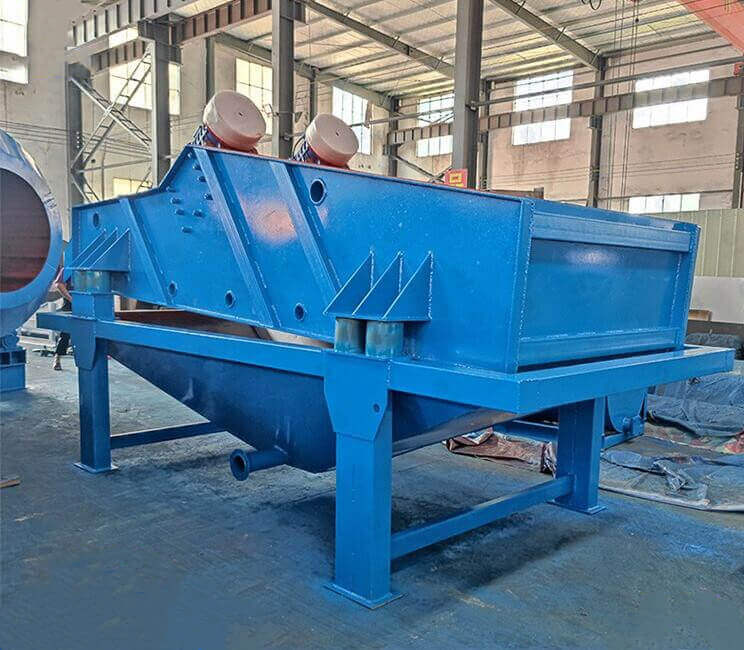A tailings dewatering screen is a piece of equipment used to process tailings (the waste left over after ore has undergone flotation or other extraction processes). Its primary function is to dehydrate the water in the tailings to reduce the waste volume and increase the tailings’ solid content. It helps reduce the environmental impact of tailings and makes the waste more straightforward to handle and dispose of.
Tailings dewatering screens usually use the principle of vibrating screening. Through the movement of the vibrating screen, the water in the tailings is gradually removed, thereby achieving the dehydration effect. These devices usually include screens that separate moisture from solid particles through suitable mesh sizes.
Dewatered tailings are typically output with a lower moisture content, which makes the tailings easier to handle and transport. The tailings dewatering screen is widely used in mining, metallurgy, building materials, and other industries. It can handle various types of tailings with different properties and has the advantages of large processing capacity, high efficiency, and easy operation. Using tailings dewatering screens can improve the resource utilization of tailings, reduce the environmental impact, and meet the requirements of sustainable development.
Tailings Dewatering Screens Application
Tailings dewatering screens find application in various industries and processes where the separation of water from solid particles in slurry or tailings is essential. The primary application scope includes:
- Mining Industry: Dewatering screens are widely used in mining, particularly in mineral processing plants, to manage and process tailings generated during ore extraction and beneficiation.
- Metallurgy: Metallurgical processes often produce tailings that require dewatering. Tailings from smelting, refining, and other metallurgical operations can benefit from dewatering screens.
- Aggregate and Sand Processing: Dewatering screens are used in aggregate and sand processing plants to remove excess water from the final product, facilitating handling, transportation, and storage.
- Construction and Civil Engineering: Dewatering screens play a role in construction projects and civil engineering applications where slurry separation is necessary, such as tunneling and excavation.
- Coal Industry: Tailings dewatering screens are employed in coal preparation plants to manage the tailings generated during coal washing.
- Chemical Industry: Processes in the chemical industry, including the production of various chemicals and pharmaceuticals, may generate slurry or by-products that require dewatering.
Tailings Dewatering Screening Purchasing Precautions
The tailings dewatering screen is an indispensable equipment in tailings treatment. It can effectively increase the solid content of tailings, reduce the volume of tailings, and reduce transportation and processing costs. It is essential for improving mining enterprises’ economic benefits and environmental protection. The benefits are of great significance. Therefore, in tailings treatment, it is necessary to select and correctly use tailings dewatering screens reasonably.
When selecting and purchasing a tailings dewatering screen, it is best to communicate with a professional engineer or manufacturer to fully understand the technical specifications and performance of the equipment to ensure that the selected equipment can best meet your production needs. Here are some key things to note when choosing a tailings dewatering screen.
- Screening efficiency: Ensure that the tailings dewatering screen has efficient screening performance and can effectively separate water from the tailings. Find out if screening efficiency matches your processing needs.
- Processing capacity: Consider the processing capacity of the tailings dewatering screen, that is, the amount of tailings processed per hour. Make sure its processing capacity is sufficient to meet your production requirements.
- Screen design: Different tailings may have different particle sizes and shapes, so choosing the right screen is crucial. The pore size and design of the screen should be consistent with the characteristics of the tailings.
- Equipment Durability: Consider the durability and reliability of the tailings dewatering screen. Choose wear-resistant and corrosion-resistant materials to ensure the equipment maintains stable performance over long periods of operation.
- Maintenance convenience: Choose a design that is easy to maintain and clean to ensure that the equipment can be easily maintained and maintained during use and reduce downtime.
- Energy consumption: Consider the energy efficiency of the equipment and select a tailings dewatering screen that can meet processing needs while minimizing energy consumption.
- Manufacturer reputation: Choose a manufacturer or supplier with a good reputation. They can provide reliable quality equipment and good after-sales service.
- Cost considerations: Not only consider the initial investment cost of purchasing a tailings dewatering screen but also the long-term operating costs, including energy consumption, maintenance, and spare parts costs.
- Regulatory and Environmental Requirements: Ensure that the selected equipment complies with local and national regulatory requirements, especially environmental standards.
When selecting a tailings dewatering screen, factors such as the nature of the tailings, processing capacity, equipment wear resistance, and maintenance costs need to be considered to ensure that equipment suitable for your production needs is selected. In addition, when using and maintaining the tailings dewatering screen, it is necessary to strictly follow the operating procedures and conduct regular inspections and maintenance of the equipment to ensure its normal operation and extend its service life.
JXSC specializes in manufacturing high-performance tailings dewatering screens, precision-engineered to efficiently separate water from mineral and aggregate tailings, providing a sustainable solution for reducing environmental impact and optimizing resource utilization in mining and mineral processing operations.
LATEST PRODUCTS
Twin Screw Feeder
【Feeding Capacity】 10-160 t/h【Power】 2.2-…
Tubular Screw Conveyor
【Capacity】6-50 m3/h【Procesible Material】 …
Heavy Plate Feeder
Capacity: 100-240 m3/h Power: 15-45 kW Speed: 0…










